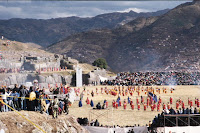‘The " Inti Raymi" or " Sun Festivity" was the biggest, most important, spectacular and magnificent festivity carried out in pre-Hispanic times. It was aimed to worship the " Apu Inti" (Sun God) also known in certain sectors as " Apu P'unchau" (Day God). It was performed every year on June 21, that is, in the winter solstice of the Southern Hemisphere, in the great Qosqo's Main Plaza. In the Andean Mythology it was considered that Inkas were descendants of the Sun, therefore, they had to worship it annually with a sumptuous celebration. More over, the festivity was carried out by the end of the potatoes and maize harvest in order to thank the Sun for the abundant crops or otherwise in order to ask for better crops during the next season. Besides, it is during the solstices when the Sun is located in the farthest point from the earth or vice versa, on this date the Quechuas had to perform divers rituals in order to ask the Sun not to abandon its children.’
‘Nowadays, the Inti Raymi is staged annually in Saqsaywaman, the day of Saint John, that is, on June 24th. That same day is also the " Indians Day" or " Peasants Day" in Peru. The Inti Raymi was established in the Qosqo's festivity calendar since 1944 thanks to enthusiasm of Cusquenian Dr. Humberto Vidal Unda.’
(www.qosqo.com/qosqo/festivit.htm)
The festival starts at the site of the Sun Temple, near the town centre. We went to watch the procession as it went from the Sun Temple up to the Plaza de Armas and found a good spot on a side road where we could see well. It is useful that we are taller than most Peruvians!
 There were people dressed in the costumes of an Inca army, various men and women carrying offerings of maize and coca leaves, lots of musicians, the Inca queen (carried on a platform) and finally someone playing the part of the Inca himself.
There were people dressed in the costumes of an Inca army, various men and women carrying offerings of maize and coca leaves, lots of musicians, the Inca queen (carried on a platform) and finally someone playing the part of the Inca himself.
 At the Plaza de Armas the procession stops for a ceremony and then continues up to Sacsaywaman, the Inca ruins above Cusco, where more ceremonies and dances take place. We were at church while the ceremony was taking place in the plaza, and then went up to Sacsaywaman later to see some more. Apparently it cost $80 for a seat in the grandstand, but we (and most of the population of Cusco) could see quite well for free from the surrounding rock outcrops and hills! Sammy walked several miles and climbed up several hundred steps as it was difficult to find a bus or a taxi with between 100 and 200,000 people in Cusco!
At the Plaza de Armas the procession stops for a ceremony and then continues up to Sacsaywaman, the Inca ruins above Cusco, where more ceremonies and dances take place. We were at church while the ceremony was taking place in the plaza, and then went up to Sacsaywaman later to see some more. Apparently it cost $80 for a seat in the grandstand, but we (and most of the population of Cusco) could see quite well for free from the surrounding rock outcrops and hills! Sammy walked several miles and climbed up several hundred steps as it was difficult to find a bus or a taxi with between 100 and 200,000 people in Cusco!
A tourist leaflet explains the ceremonies and gives a Spanish translation of the Quechua ‘order of service’. Here are a few bits I’ve translated into English!
My sun, my father!
With much joy we greet you,
Greet us with your light
My sun, my father!
My sun, my father!
You give strength to the whole world
Have compassion on us with your heat,
My sun, my father!
Powerful sun, only father!
Fountain of warmth, provider of happiness.
We salute you with joy and worship you on your day of celebration.
God of the day!
Burning sun!
Oh father, supreme being! Oh Sun god! Oh god of Lightening! Oh Feline god of the Stars! Oh Mother Moon! Oh Mother Earth! Oh Ausangati, Salqantay, Wanakauri, Pachatusan, Saqsaywaman! (all these are mountains/high places) Be always young, never grow old! Give us peace; let our people multiply and let everything always increase! Let us have food and hunger disappear forever!
Ceremonies include:
Coca leaf ceremony
Chicha ceremony
Sacred fire ceremony
Llama sacrifice
The whole event is very much a re-enactment in contrast to festivals such as Corpus Christi which have real meaning for people. Some people do have some of the beliefs associated with Inti Raymi but it seems to be more of an event for tourists than anything! Probably some evangelical churches would disapprove of their congregation going along but ours had no problem with it.





No comments:
Post a Comment